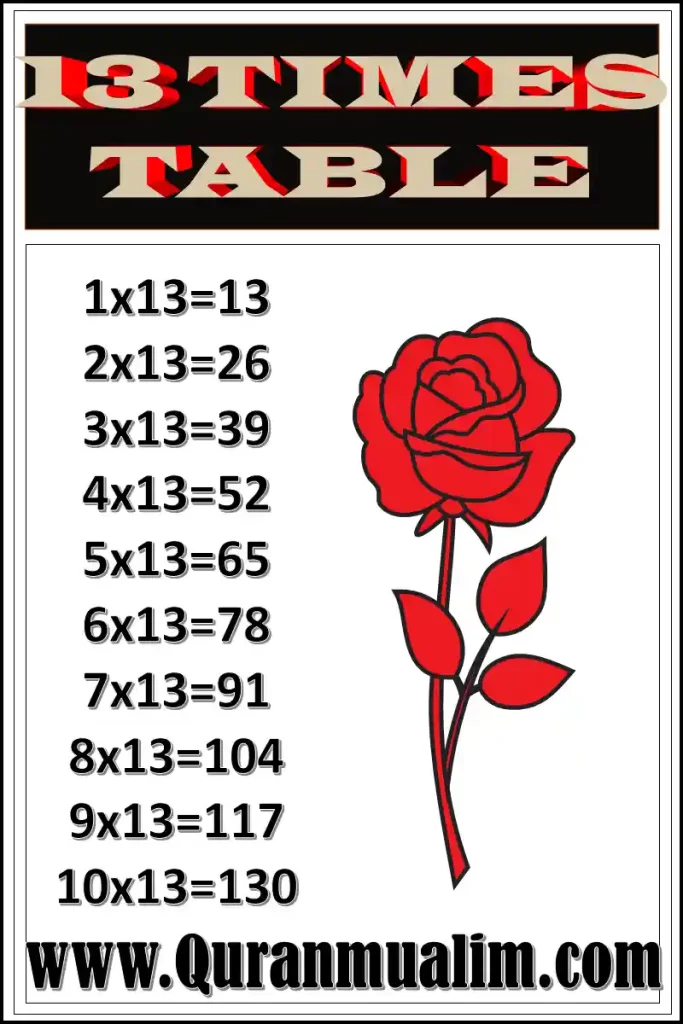13 Times Table (Times Tables) – Welcome to the fascinating world of multiplication! Among the many multiplication tables that you’ll encounter, the Thirteen times table holds a special place. In this journey of numbers, we will explore the wonders of the Thirteen times table, discover its patterns, and unveil the tricks that make it easier to learn and master.
Multiplication is a fundamental mathematical operation that lies at the core of various mathematical concepts and real-world applications.
It is the art of combining numbers to find their total value when they are repeated a certain number of times. The Thirteen times table, like all other multiplication tables, is a collection of facts that reveal the products of multiplying 13 with every whole number from 1 to 12.
At first glance, the Thirteen times table might seem intimidating, but fear not! We are here to guide you through the process of understanding and memorizing this table with ease and confidence.
By the end of this journey, you’ll be amazed at how the seemingly complex calculations become second nature, empowering you with enhanced mental math skills and boosting your overall mathematical proficiency.
In this exploration, we will delve into various techniques and tricks to make the Thirteen times table a breeze to learn. From understanding patterns and relationships to breaking down larger problems into more manageable components, we will equip you with the tools you need to navigate through the 13 times table with speed and accuracy.
Beyond the practical benefits, mastering the Thirteen times table will open doors to deeper mathematical understanding. It will serve as a solid foundation for tackling more complex math concepts and problems that lie ahead in your academic journey.
So, whether you are a student looking to excel in mathematics or an enthusiast eager to strengthen your mental math skills, this journey into the world of the Thirteen times table will prove to be an invaluable and rewarding experience.
Are you ready to embark on this mathematical adventure? Let’s dive into the enchanting realm of the 13 times table and uncover its secrets together!

Math Corner
- Suggested Read: algebra functions and data analysis
- Suggested Read: Math kangaroo past papers
- Suggested Read: Basic geometry worksheets pdf
- Suggested Read: Algebra 2 formula sheet pdf
- Suggested Read: Geometry formulas pdf
- Suggested Read: algebra 2 cheat sheet pdf

What is multiplication?
Thirteen Times Table (Times Tables) – Multiplication is a fundamental arithmetic operation that combines two or more numbers to find their total value when they are repeated a certain number of times.
It is represented by the symbol “x” or “*”, and the result of multiplication is called the product. For example, in the expression 3 x 4, 3 is multiplied by 4 to yield a product of 12. In essence, multiplication is a shortcut for adding the same number multiple times.
Thirteen Times Table (Times Tables) 13 Times Table (Times Tables) – Learning Drives Tables that contains 13 is 13 which can be described as the sum divided by whole numbers.
The understanding of Thirteen times tables can help students learn more easily in secondary school and beyond. Together with 13 times tables students must learn division concepts. For example the division rules from the table 13 comprise 39/13 = 352 13 = 4,65 13/5. This is the basis for division of additional numbers.
13 Times Chart Table:
We make 13 times table that:
1 x 13 =12
2 x 13 =26
3 x 13 = 39
4 x 13 = 52
5 x 13 = 65
6 x 13 = 78
7 x 13 = 91
8 x 13 = 104
9 x 13 = 117
10 x 13 = 130
11 x 13 = 143
12 x 13 = 156
Multiplication Table for 13
Table of 13 helps when it comes to calculation for long multiplications and divisions that are multiplications. Let’s examine the first 10 multiplications in this 13 table.
13 Times Table
- 13 Times Table, up to 10
- 13 1 equals 13 6 = 78
- 13, 2 equals 26, 13 7 = 91
- 13 3 equals 39. 13 times 8 =104
- 13 4 = 52 13 9 = 117
- 13 5 = 6513 10 = 130
Strategies for the 13 Times Table
1. To memorize the 13 times table, it is necessary to learn the 3 times table. 3 multiples include 9, 12, 15, 18, 21, 24, 27-30 . . . .
2. To obtain the multiples of 13, simply add naturally occurring numbers to the 10th number, which is three times. This table of 13 could be calculated as follows: (1+0)3, (2+0)6, (3+0)9, (4+1)2, (5+1)5, (6+1)8, (7+2)1, (8+2)4, (9+2)7, (10+3)0 = 13 26 39 52 65, 78 1 117 130.
3. 13 doesn’t have specific rules to makes the table of 13 multiplication easy to remember. However there is a pattern that can be found for each ten times of three: 13, 26, 3952, 65 and the numbers 78,91 and 130, 117. The last digit of these multiples will always be repeated to ensure that students are in a position to recall the numbers in order to comprehend how to read the 13-times table.
Table of 13 to 20
The table below the next section, you can check the 10 subsequent multiples of 13 and up to 20.
- 13 x 11 = 208
- 13 x 12 = 221
- 13 x 13 = = 234
- 13 x 13 == 247
- 13 x 15 = 260
The Thirteen Times Table in form of words?
- 13 times table in words is,
13 times 1 equals 13
The sum of 13 times two equals 26
13, multiplied by 3, equals 39.
The sum of 13 times four equals 52.
The sum of 13 x 5 is equal 65.
13 times 6 equals the number 78.
13,7 times 13 equals 91.
13,8 equals 104.
13,9 equals the number 117.
13 times 10 equals 130.
What is 13 times 13?
13×13 equals 13 times the number 169.
In the table in the table above we multiply 13 times 3, which yields 39. Then we add the three digits tens ( 3) from 39 to 13, and we receive 16. Singles ( 9) from 39 is later added to make the singles digit in the final result. the result is the sum in the range of 169.
Doesn’t this seem simple to implement? This trick would have helped me save a lot of time when I was in school but is not a problem. The best part is that I’m in a position to demonstrate this method to my children and assist to make their lives comfortable.
I think it’s a great alternative to other methods for retaining times tables.
Tips & Tricks
- Memorize the Pattern: Notice that the units digit of the product follows a pattern: 3, 6, 9, 2, 5, 8, 1, 4, 7, 0. Learning this pattern can make multiplication quicker.
- Break it Down: Use known facts to your advantage. For instance, to find 13 x 7, you can break it down as (10 x 7) + (3 x 7) = 70 + 21 = 91.
- Practice Regularly: Consistent practice is key to mastering any times table, including the 13 times table. Make use of flashcards or online drills to reinforce your knowledge.
- Use Visual Aids: Draw arrays or grids to visually represent the multiplication, which can be especially helpful for visual learners.
- Focus on the Half Table: The half table of 13 (1 to 6) can be easier to memorize, and you can then double the result for the corresponding facts (e.g., 13 x 8 is double of 13 x 4).
- Find Real-Life Applications: Relate the 13 times table to real-life situations, such as measuring time or calculating quantities in a baker’s recipe.
- Play Multiplication Games: Engage in fun multiplication games to make learning more enjoyable and interactive.
Benefits
- Enhanced Mental Math Skills: Mastering the 13 times table improves mental math abilities, helping in quick calculations in various situations.
- Time-Saving: Having the 13 times table readily available in a table format saves time during calculations.
- Confidence Booster: Knowing the 13 times table by heart boosts confidence in mathematics and overall problem-solving skills.
- Foundation for Advanced Math: A strong grasp of multiplication lays the foundation for learning more complex math concepts later on.
Facts:
1 x 13 = 13 2 x 13 = 26 3 x 13 = 39 4 x 13 = 52 5 x 13 = 65 6 x 13 = 78 7 x 13 = 91 8 x 13 = 104 9 x 13 = 117 10 x 13 = 130 11 x 13 = 143 12 x 13 = 156
Why is the 13 Times Table so Easy to Learn?
The 13 times table is often considered easy to learn due to its recurring patterns and relationships with other multiplication facts. The consistent pattern in the units digit (3, 6, 9, 2, 5, 8, 1, 4, 7, 0) makes it easier to remember the results. Additionally, breaking down larger multiplication problems using known facts further simplifies the learning process.
Questions & Answers
Q: What is 13 times 9? A: 13 times 9 is 117.
Q: How can you find 13 times 11? A: To find 13 times 11, you can add 13 to the product of 10 times 11 (10 x 11 = 110), resulting in 143.
Q: What is the units digit pattern in the 13 times table? A: The units digit pattern in the 13 times table is 3, 6, 9, 2, 5, 8, 1, 4, 7, and 0.
Q: How can you use the half table to find 13 times 6? A: The half table shows that 13 times 3 is 39. To find 13 times 6, you double the result, which is 78.
Mastering the 13 Times Tables:
Mastering the 13 times table requires regular practice, memorization, and understanding the underlying patterns. Practice with flashcards, games, and exercises to reinforce your knowledge.
As you become more familiar with the table, try to recall facts from memory rather than relying on counting or other aids.
Keep up the
- Also Read: Where To Take An IQ Test?
- Also Read: Where Can I Take An IQ Test?
- Also Read: Noetic Math Contest 2022
- Also Read: 11 Best Preschool Free IQ Tests for Kids
- Also Read: IQ Test For Kids 10-15 Free PDF Download
- Also Read: International Contest Math Kangaroo Canada
Conclusion – 13 Times Table:
(Times Tables) – The 13 times table is a valuable multiplication skill that offers numerous benefits in mathematics and daily life.
By employing various tips and tricks, such as memorising the pattern, breaking down larger problems, and using visual aids, learning the 13 times table becomes more accessible and enjoyable.
With consistent practice and dedication, anyone can master the Thirteen times table and improve their overall mathematical proficiency.
Related Articles:
Here are More Times Table lists for you!
- 1 Times Table (Times Tables)
- 2 Times Table (Times Tables)
- 3 Times Table (Times Tables)
- 4 Times Table (Times Tables)
- 5 Times Table (Times Tables)
- 6 Times Table (Times Tables)
- 7 Times Table (Times Tables)
- 8 Times Table (Times Tables)
- 9 Times Table (Times Tables)
- 10 Times Table (Times Tables)
- 11 Times Table (Times Tables)
- 12 Times Table (Times Tables)
- 13 Times Table (Times Tables)
Multiplication 1-15
Multiplication Tables 1-12
Multiplication Tables 1-30
Multiplication Tables 1-40
Multiplication Tables 1-50
Multiplication-Tables 1- 100








